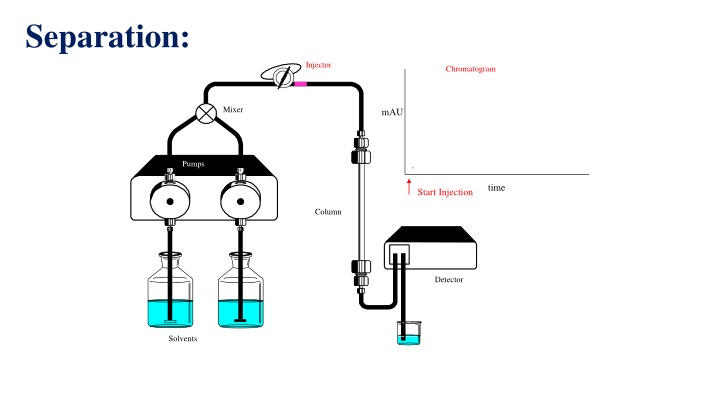
Chromatography Separation Techniques Explained
Discover the science behind chromatography separation with detailed images showcasing the process of Injector, Chromatogram, Mixer, Pumps, and more. Explore various steps involved in separation for an in-depth understanding of the methodology.
Download Presentation

Please find below an Image/Link to download the presentation.
The content on the website is provided AS IS for your information and personal use only. It may not be sold, licensed, or shared on other websites without obtaining consent from the author. If you encounter any issues during the download, it is possible that the publisher has removed the file from their server.
You are allowed to download the files provided on this website for personal or commercial use, subject to the condition that they are used lawfully. All files are the property of their respective owners.
The content on the website is provided AS IS for your information and personal use only. It may not be sold, licensed, or shared on other websites without obtaining consent from the author.
E N D
Presentation Transcript
Separation: Injector Chromatogram Mixer mAU Pumps time Start Injection Column Detector Solvents
Separations Injector Chromatogram Mixer mAU Pumps time Start Injection Column Detector Solvents
Separations Injector Chromatogram Mixer mAU Pumps time Start Injection Column Detector Solvents
Separations Injector Chromatogram Mixer mAU Pumps time Start Injection Column Detector Solvents
Separations Injector Chromatogram Mixer mAU Pumps time Start Injection Column Detector Solvents
Separations Injector Chromatogram Mixer mAU Pumps time Start Injection Column Detector Solvents
Separations Injector Chromatogram Mixer mAU Pumps time Start Injection Column Detector Solvents
Separations Injector Chromatogram Mixer mAU Pumps time Start Injection Column Detector Solvents
Separations Injector Chromatogram Mixer mAU Pumps time Start Injection Column Detector Solvents
Separations Injector Chromatogram Mixer mAU Pumps time Start Injection Column Detector Solvents
Separations Injector Chromatogram Mixer mAU Pumps time Start Injection Column Detector Solvents
Separations Injector Chromatogram Mixer mAU Pumps time Start Injection Column Detector Solvents
Separations Injector Chromatogram Mixer mAU Pumps time Start Injection Column Detector Solvents
Separations Injector Chromatogram Mixer mAU Pumps time Start Injection Column Detector Solvents
Separations Injector Chromatogram Mixer mAU Pumps time Start Injection Column Detector Solvents
Types of HPLC: Normal phase chromatography. Reversed-phase chromatography.
Normalphase chromatography Normal phase chromatography was one of the first kinds of HPLC that chemists developed. Also known as normal-phase HPLC (NP-HPLC) this method separates analytes based on their affinity for a polar stationary surface such as silica. NP-HPLC uses a non-polar, non-aqueous mobile phase (e.g. Chloroform), and works effectively for separating analytes readily soluble in non-polar solvents. The analyte associates with and is retained by the polar stationary phase
Reversed-phase chromatography: Reversed phase HPLC (RP-HPLC) has a non-polar stationary phase , moderately polar mobile phase. One common stationary phase is a silica which has been surface- modified with RMe2SiCl, where R is a straight chain alkyl group such as C18H37or C8H17. With such stationary phases, retention time is longer for molecules which are less polar, while polar molecules elute more readily (early in the analysis). An investigator can increase retention times by adding more water to the mobile phase
Stationary Phases: Polar (Normal Phase): Silica, alumina Non-Polar (Reversed Phase): ODS Silica gel, C18, C8
Chromatography Stationary Phases Derivatized Silica Gel Silica Gel O O O | | | O Si O Si O Si O R | | | O O O | | | O Si O Si O Si O R | | | O O O O O O | | | O Si O Si O Si O H | | | O O O | | | O Si O Si O Si O H | | | O O O Where R = C18H37 hydrocarbon chain (octadecylsilyl deriv. silica or C18 ) relatively polar surface relatively nonpolar surface reversed phase normal phase
Normal vs. Reversed Phase Chromatography Normal Phase Reversed Phase Stationary phase Polar (silica gel) Non-polar (C18) Non-polar (organic solvents) Polar Mobile phase (aqueous/organic) Sample movement Non-polar fastest Polar fastest Different polarities (functionality) Different Separation based on hydrocarbon content
TLC vs. HPLC: Type of Analysis qualitative only qualitative & quantitative 3-dimensional column much! with many adjustable parameters injection (Rheodyne injector) high pressure (solvent delivery) on-line detection (variable UV/Vis) peaks, Rt s (retention times) Stationary Phase 2-dimensional thin layer plate minimal! Instrumentation Sample Application spotting (capillary) capillary action (during development) UV lightbox Mobile Phase Movement Visualization of Results Form of Results spots, Rf s (retention factors)
Application of HPLC 1. Pharmaceuticals industry To control the drug stability Quantity of drug determination from pharmaceutical dosage forms, ex. Paracetamol determination in panadol tablet Quantity of drug determination from biological fluids, ex: blood glucose level 2. Analysis of natural contamination Phenol & Mercury from sea water 3. Forensic test Determination of steroid in blood, urine & sweat. 4. Clinical test
HPLC Applications Consumer Products Bioscience Chemical proteins peptides nucleotides polystyrenes dyes phthalates lipids antioxidants sugars Pharmaceuticals Clinical Environmental tetracyclines corticosteroids antidepressants barbiturates polyaromatic hydrocarbons Inorganic ions herbicides amino acids vitamins homocysteine
The Factors Which Influence The HPLC Performance: Internal diameter of column The smaller in diameter, the higher in sensitivity. Pump pressure The higher in pressure, the higher in separation. Sample size The polarity sample, solvent and column Temperature The higher in temperature, the higher in separation.
Advantages: Needs a small sample with a high accuracy and precis Non-destructed sample during operation compared to GC.
Disadvantages: Need a skill to run the instruments. Solvents consuming.















